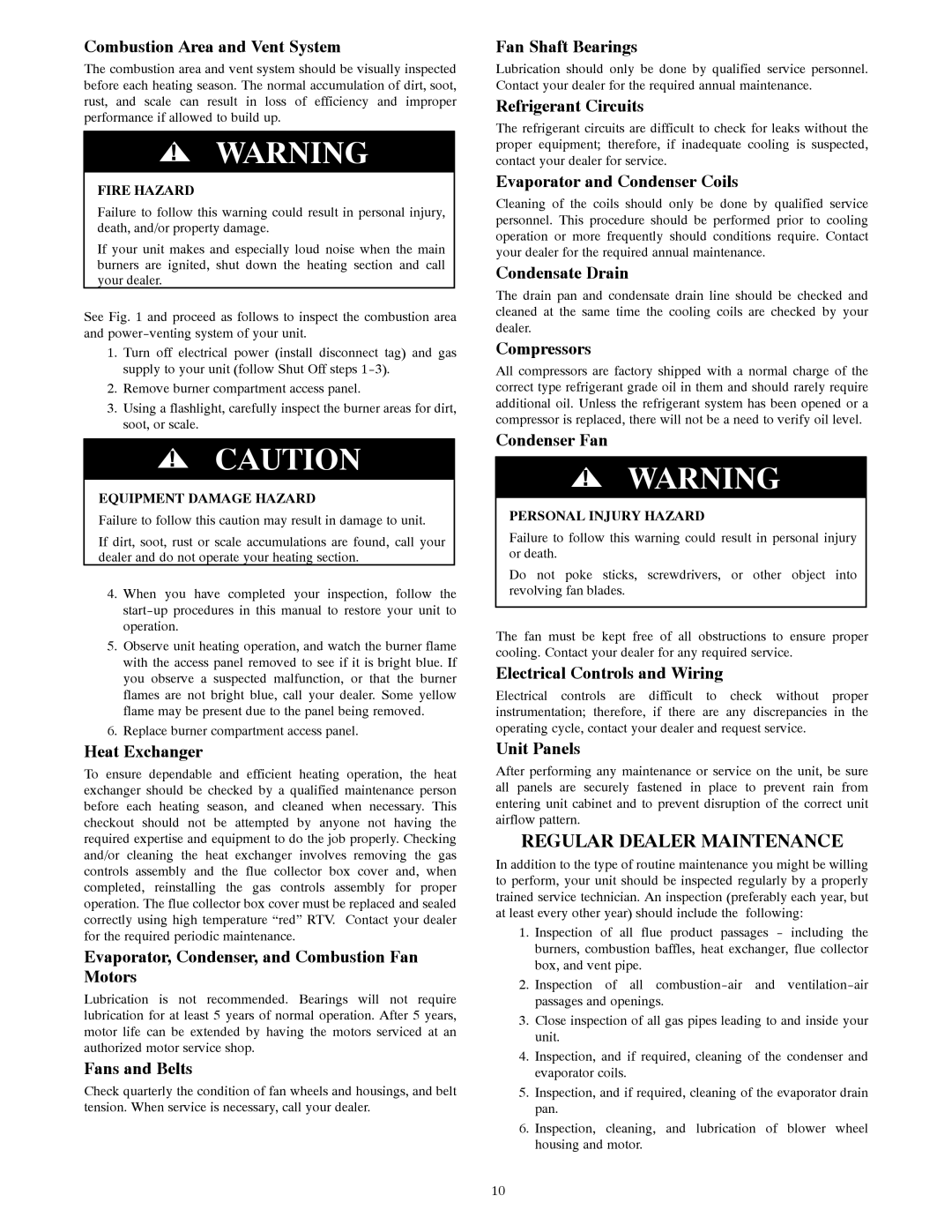Combustion Area and Vent System
The combustion area and vent system should be visually inspected before each heating season. The normal accumulation of dirt, soot, rust, and scale can result in loss of efficiency and improper performance if allowed to build up.
!WARNING
FIRE HAZARD
Failure to follow this warning could result in personal injury, death, and/or property damage.
If your unit makes and especially loud noise when the main burners are ignited, shut down the heating section and call your dealer.
See Fig. 1 and proceed as follows to inspect the combustion area and power-venting system of your unit.
1.Turn off electrical power (install disconnect tag) and gas supply to your unit (follow Shut Off steps 1-3).
2.Remove burner compartment access panel.
3.Using a flashlight, carefully inspect the burner areas for dirt, soot, or scale.
!CAUTION
EQUIPMENT DAMAGE HAZARD
Failure to follow this caution may result in damage to unit.
If dirt, soot, rust or scale accumulations are found, call your dealer and do not operate your heating section.
4.When you have completed your inspection, follow the start-up procedures in this manual to restore your unit to operation.
5.Observe unit heating operation, and watch the burner flame with the access panel removed to see if it is bright blue. If you observe a suspected malfunction, or that the burner flames are not bright blue, call your dealer. Some yellow flame may be present due to the panel being removed.
6.Replace burner compartment access panel.
Heat Exchanger
To ensure dependable and efficient heating operation, the heat exchanger should be checked by a qualified maintenance person before each heating season, and cleaned when necessary. This checkout should not be attempted by anyone not having the required expertise and equipment to do the job properly. Checking and/or cleaning the heat exchanger involves removing the gas controls assembly and the flue collector box cover and, when completed, reinstalling the gas controls assembly for proper operation. The flue collector box cover must be replaced and sealed correctly using high temperature “red” RTV. Contact your dealer for the required periodic maintenance.
Evaporator, Condenser, and Combustion Fan Motors
Lubrication is not recommended. Bearings will not require lubrication for at least 5 years of normal operation. After 5 years, motor life can be extended by having the motors serviced at an authorized motor service shop.
Fans and Belts
Check quarterly the condition of fan wheels and housings, and belt tension. When service is necessary, call your dealer.
Fan Shaft Bearings
Lubrication should only be done by qualified service personnel. Contact your dealer for the required annual maintenance.
Refrigerant Circuits
The refrigerant circuits are difficult to check for leaks without the proper equipment; therefore, if inadequate cooling is suspected, contact your dealer for service.
Evaporator and Condenser Coils
Cleaning of the coils should only be done by qualified service personnel. This procedure should be performed prior to cooling operation or more frequently should conditions require. Contact your dealer for the required annual maintenance.
Condensate Drain
The drain pan and condensate drain line should be checked and cleaned at the same time the cooling coils are checked by your dealer.
Compressors
All compressors are factory shipped with a normal charge of the correct type refrigerant grade oil in them and should rarely require additional oil. Unless the refrigerant system has been opened or a compressor is replaced, there will not be a need to verify oil level.
Condenser Fan
!WARNING
PERSONAL INJURY HAZARD
Failure to follow this warning could result in personal injury or death.
Do not poke sticks, screwdrivers, or other object into revolving fan blades.
The fan must be kept free of all obstructions to ensure proper cooling. Contact your dealer for any required service.
Electrical Controls and Wiring
Electrical controls are difficult to check without proper instrumentation; therefore, if there are any discrepancies in the operating cycle, contact your dealer and request service.
Unit Panels
After performing any maintenance or service on the unit, be sure all panels are securely fastened in place to prevent rain from entering unit cabinet and to prevent disruption of the correct unit airflow pattern.
REGULAR DEALER MAINTENANCE
In addition to the type of routine maintenance you might be willing to perform, your unit should be inspected regularly by a properly trained service technician. An inspection (preferably each year, but at least every other year) should include the following:
1.Inspection of all flue product passages - including the burners, combustion baffles, heat exchanger, flue collector box, and vent pipe.
2.Inspection of all combustion-air and ventilation-air passages and openings.
3.Close inspection of all gas pipes leading to and inside your unit.
4.Inspection, and if required, cleaning of the condenser and evaporator coils.
5.Inspection, and if required, cleaning of the evaporator drain pan.
6.Inspection, cleaning, and lubrication of blower wheel housing and motor.

